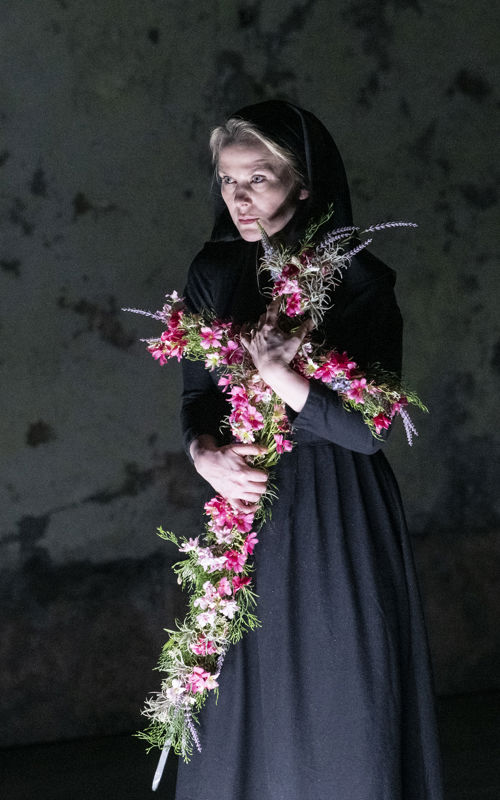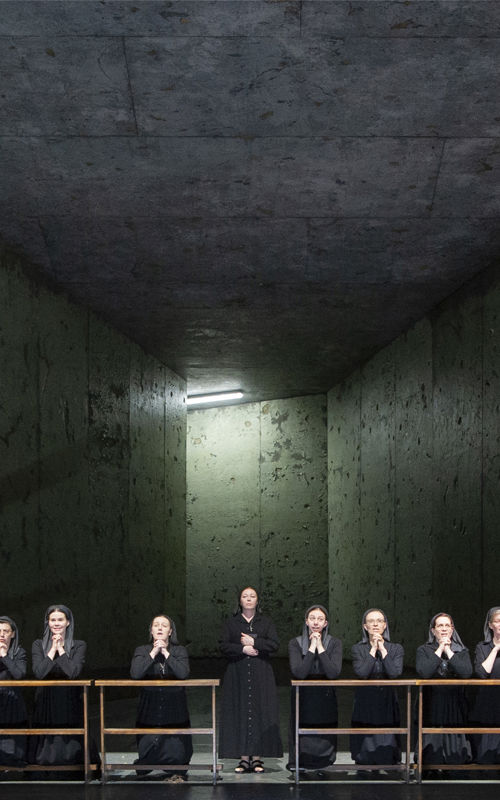Dialogues
des
Carmélites
 Mari Eriksmoen / Photo: Erik Berg
Mari Eriksmoen / Photo: Erik Berg
What is
more terrifying –
to die or to live?
Trying to escape all the suffering in the world, a young girl joins a convent. However, as the convent walls are unable to keep the pain out, she must find peace within herself. A strong and beautiful opera that leaves no one untouched!
A radical young woman
The French Revolution is at its most brutal. Looking for meaning in the meaningless, Blanche de la Force runs away to a convent. But life as a nun has its own brutality. Faced with a difficult decision, Blanche has to let go of fear and find the courage to live – or die.
Beautiful choral singing and cinematic music
Dialogues des Carmélites is based on an actual event that took place 200 years ago. The music, on the other hand, is relatively new. It was written by the French composer Francis Poulenc in 1957.
Poulenc is famous for his incredibly beautiful choral music. The reason is blatantly obvious on hearing the nuns in ‘Ave Maria’ and ‘Salve Regina’. The music may also bring to mind operas by Debussy, Monteverdi and Verdi. It is lyrical and intense, almost like film music – only better.
On stage are a delightful group of singers, with Mari Eriksmoen in the lead as Blanche.
You should beg, buy or perhaps pray for a ticket.
– RICHARD MORRISON, THE TIMES
Staged by first-class director
“What I’m going to do with this opera is to explore the claustrophobia – the emotional and psychological claustrophobia of this convent. A convent is a place that is cut off from the rest of this world. It’s a place of secrets, a place of ambiguity, a place where emotional and psychological forces have no way to escape but collide against each other,” explains director Barrie Kosky.
Kosky is known for directing performances of exceptionally high artistic quality. An opera staged by the former artistic director of the Komische Oper Berlin can now finally be experienced in Oslo. The performance premiered at Glyndebourne in June 2023 and garnered rave reviews.
This is a superlative realisation of a great opera.
– NICHOLAS KENYON, THE TELEGRAPH
Read the reviews here- Free introduction in Norwegian 1 hr before show starts
- Dialogues des Carmélites is a Glyndebourne production
Synopsis
There is a revolution in Paris, and the young aristocrat Blanche joins the Carmelite convent as a nun. When all religious houses are liquidated, the nuns are told that they must renounce their faith and return to society, or they will be executed. Blanche returns to her family, but when the nuns are arrested, she rejoins them – and faces death.
© Glyndebourne Productions Ltd
The Revolution is gaining pace, and every day the streets of Paris become less safe. After a terrifying encounter with a mob, young aristocrat Blanche de la Force can no longer face the outside world, and announces to her father and brother her intention to join the Carmelite order as a nun. But once at the convent, the Old Prioress makes clear to the frightened girl that the church is a place of prayer, not refuge. Blanche vows to face her fears.
Blanche and Sister Constance talk while they perform their chores. Both are struck by the Old Prioress’ illness and conversation turns to death. Constance suggests that she and Blanche offer their lives up for that of the Prioress, but Blanche rejects the idea angrily. Constance persists, sharing her belief that they will both die young, and on the same day.
In the infirmary the Old Prioress, Madame de Croissy, is dying. Before her death she entrusts Blanche, the newest member of the order, to the care of Mother Marie. Suddenly fearful and angry, despite a lifetime of faith and prayer, her end is agonising, witnessed by a terrified Blanche.
At night in the chapel Blanche and Constance keep vigil over the body of the Prioress. Later they talk again about her death, and Constance shares her theory that Madame de Croissy’s violent death was not her own but belonged to another. Someone else, she speculates, may find their’s unexpectedly easy as a consequence.
The new Prioress, Madame Lidoine, gathers the nuns together to reassure them as the Revolution grows. Blanche’s brother the Chevalier de la Force arrives to try and persuade his sister to flee Paris with him, but Blanche is steadfast and will not leave her sisters.
The chaplain, stripped of his office by the Revolutionaries, performs one final Mass in the convent. The nuns discuss their own fate, and Mother Marie wonders whether they will become martyrs. But the conversation is interrupted by the arrival of soldiers. All religious houses have been dissolved, and the nuns must immediately put aside their faith and rejoin the community, or else face execution.
In the ransacked and empty chapel the nuns take a vote to decide whether they will become martyrs. After a false start the vote is unanimous. Overcome with emotion, Blanche flees.
The nuns have disbanded and have once again become everyday citizens. Blanche has returned to her family home where she now works as a servant. Mother Marie pays her a visit and urges her to rejoin her sisters. Shortly afterwards, Blanche learns that the nuns have been arrested.
The Carmelites await their deaths calmly. Singing the ‘Salve Regina’, they are led to the guillotine one by one. As each blow falls the voices become fewer and fewer until just one – Sister Constance – remains. Just as she prepares to die she is startled to see Blanche stepping forwards out of the crowd. Calm and confident she walks to her death behind her sisters.
